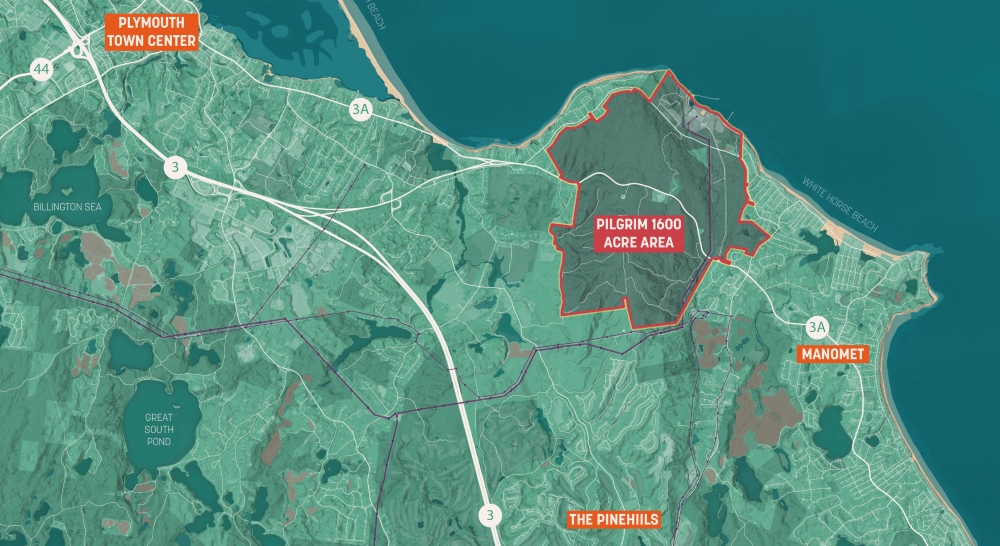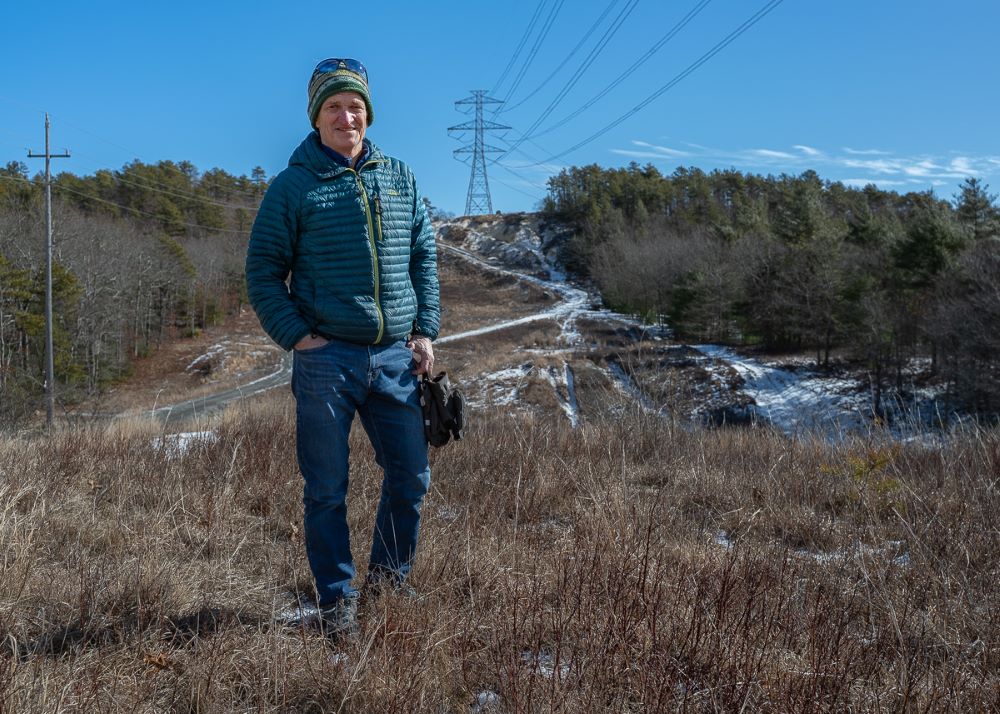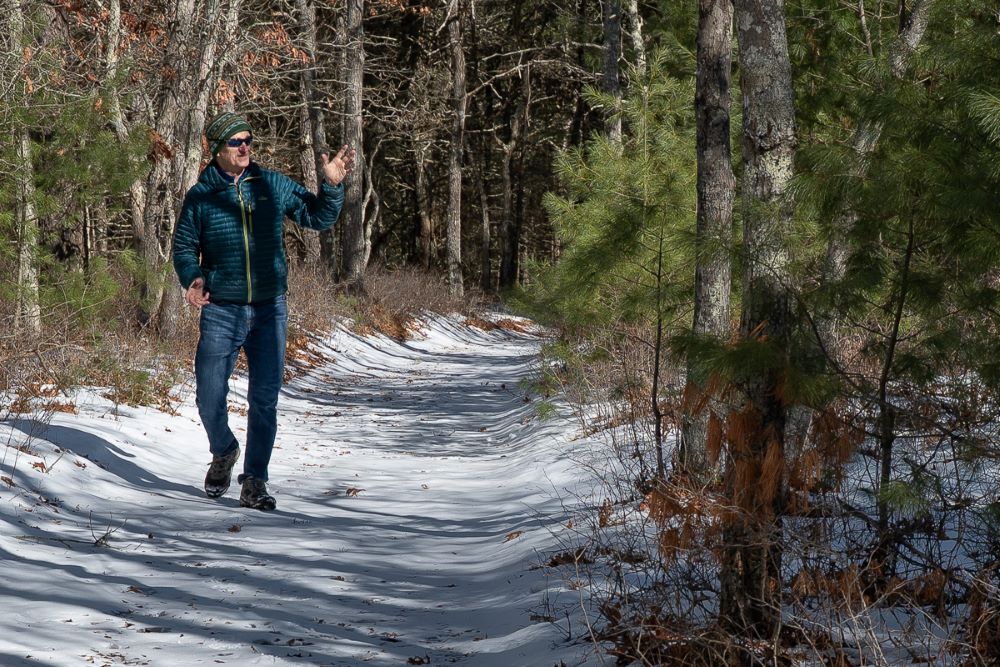On a recent day, Mark Withington walked along precarious ice-encrusted trails in the Chiltonville woods to a clearing at the boundary of the land owned by Holtec International, the company that is decommissioning the former Pilgrim nuclear power plant in Manomet.
Withington has a vision for the nearly 1,600 acres of mostly forested property around the plant. It’s centered on hiking trails that would attract tourists as well as people who live and work in Plymouth – or want to – and value outdoor recreation.
The sale of the property could be a long way off. Lee Hartmann, Plymouth’s director of planning and development, said he is not aware of any negotiations to buy the land.
Withington’s idea is one of many being floated as the town undertakes a master planning process for the day when Holtec is ready to sell the property.
To gather input on what has been dubbed the Pilgrim 1,600 Acre Plan, the town has hired planning consultants Sasaki Associates.
“We thought it would be a great opportunity to apply for a federal grant and have a professional consulting firm assist us to work with the community to say what is the community’s vision,” said Hartmann.
An online survey that generated nearly 4,000 responses found the most support for using the land for recreational and educational activities. Sixty-three percent of respondents supported mountain biking trails. (The property includes some of the Pine Hills area). Fifty-nine percent want a nature center, and 42 percent supported a recreational harbor and sailing center.
The survey was followed by a Feb. 13 public forum at which, according to Sasaki, 175 people sat around tables at Plymouth Community Intermediate School to discuss how the nearly 1,600 acres could expand the tax base, generate jobs, and provide workforce housing, as well as conservation and recreation space.
“This piece of property can do all of those things,” Withington said, by attracting “blue economy” businesses such as underwater robotics, fisheries, aquaculture, and tourism.
“The beautiful thing about tourism is they come here and spend their money (and) go home,” he said. “We don’t have to educate their children. We don’t have to plow their roads. We don’t have to provide police.”

Withington calls his proposal for the land the Pine Hills Area Trail System, or PHATS. He points to other communities that have succeeded in becoming magnets for visitors thanks to their trail networks.
For instance, in East Burke, Vermont, more than 100 miles of hiking, biking, skiing, and equestrian paths called the Kingdom Trails draw 150,000 annual visitors who have an estimated economic impact of $10 million a year.
In Northwest Arkansas, a 2023 study by the University of Arkansas found that the area’s robust network of bike trails encouraged tourism that generated $59 million in economic impact every year.
“We in Plymouth could do a similar type of thing,” Withington said. “It would have a tremendous economic impact.”
Withington calculates that hundreds of miles of trails on the Holtec property could draw 90,000 annual visitors who would spend $6 million to $12 million.
He said some parts of the 1,600 acres could be preserved without trails, while areas around Powerhouse Drive, which connects the power plant to Route 3A, could be developed.
Among the many other proposals floated at the public forum were a luxury yoga retreat, a resort hotel, a state park, bringing in the Woods Hole Oceanographic Institution, an aquarium, or a Quincy College campus.
Hartmann said the next step is a joint meeting of the Select Board, the Planning Board, and the Plymouth Economic Development Foundation, which is scheduled for Tuesday, Feb. 25. At that session, Sasaki will report on the findings from the survey and the forum and ask for input from the boards.
Another public forum is planned for Apr. 10 at which Sasaki will report to the community what it has heard from residents and will outline implications of some of the proposals.
“For example, we know that the acquisition cost for the property will be tens of millions of dollars,” Hartmann said. “So what would that look like if we actually just said we want to buy 100 percent of this property and protect 100 percent of this property?”
After the April public forum, Sasaki will once again report to the Select Board on what it heard from residents, seek the board’s input, and then come up with a final master plan, Hartmann said.
Holtec has been involved in the brainstorming from the start, Hartmann said.
“The goal is to try to build some consensus so that when the property owner comes back and says: ‘Here’s what we’d like to do,’ we can use this process as a way to work with them,” he said.
He said that, to his knowledge, there have not yet been discussions with Holtec about purchasing the land.
Holtec has not said whether it wants to sell the property.
“The problem is you don’t have a willing seller,” said Karen Grey, executive director of Wildlands Trust, a Plymouth-based nonprofit that buys and manages native habitats, farmland, and lands it considers of high ecologic and scenic value throughout Southeastern Massachusetts.
The town has in place a Nuclear Mitigation Stabilization Fund, that could be used for the eventual purchase of the land. The fund has a balance of $9.9 million. The Select Board plans to propose adding another $500,000 to it at April Town Meeting, said Kevin Canty, vice chair of the board.
The Advisory and Finance Committee voted against recommending putting more money into the fund this year, but, as happened last year, Town Meeting can override that recommendation. Last year, Town Meeting voted to add $500,000 over the objection of the Advisory and Finance Committee.
No matter what, the amount set aside is not likely to come close to the selling price.
The town has a 270-day right of first refusal on a purchase offer, said Patrick O’Brien, spokesperson for Holtec. The right of first refusal runs through 2031 and only includes the land currently under forestry, not the industrial site where the former nuclear plant is being decommissioned.

After 2031, unless a new agreement is reached, the town would have the 90-day right of first refusal allowed under state law, which is not a long time to put together the tens of millions of dollars that might be needed to match an offer from a private developer.
But even if the town cannot afford to buy the land, it can still shape development there, thanks to zoning restrictions.
The area where the power plant sits is zoned as light industrial. The forested part of the property is zoned rural residential.
Whoever acquires the property from Holtec would need the town to rezone the land to develop it, which gives the town leverage, Withington said.
Fred Thys can be reached at fred@plymouthindependent.org.

